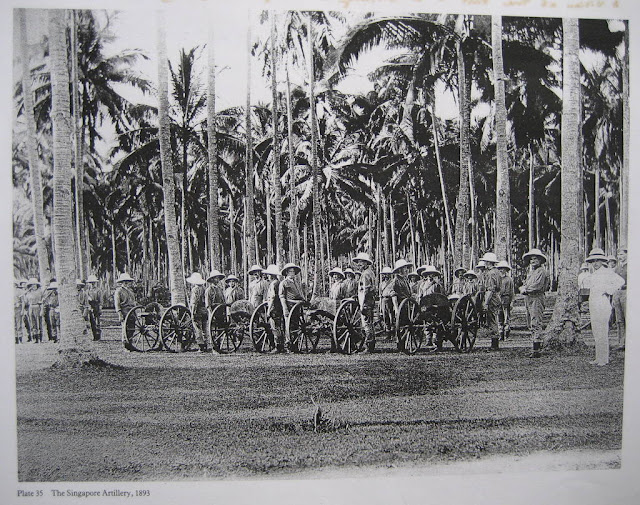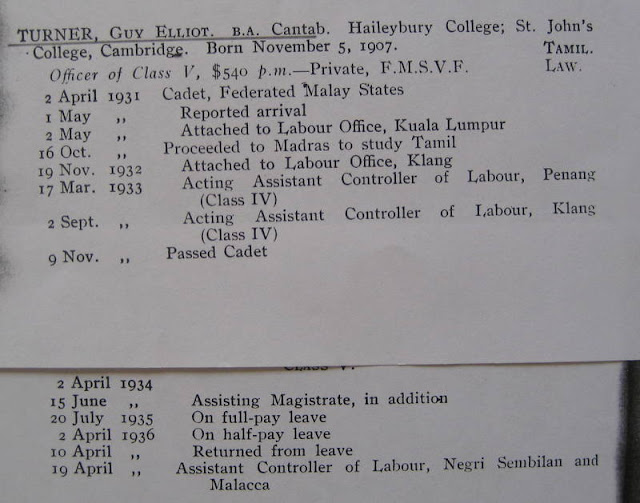 |
| Efficiency Medal Awarded to 7893 L/CPL/ WILLIAM TAYLOR, F.M.S.V.F. on 31 Aug 1950 (Ref: In Oriente Primus) |
 |
| Reverse of Medal |
Pg 319, In Oriente Primus
Taylor W.B.
Born 1912 Midlothian. Assistant Planter, Sungei Wangi Estate. Enlisted VF [Volunteer Force] 8.37 [Aug 1937]. L/Cpl 7893 3FMSVF [Negri Semilan] POW Singapore. Returned to Malaya 1946: Temiang Estates, Seremban NS [Negri Sembilan]
The Efficiency Medal is the equivalent for N.C.O.'s and men of the Efficiency Decoration and was instituted at the same time, but is granted after twelve years service and a bar is issued for every six years thereafter. The service to be continuous, however, unless under exceptional circumstances as laid down. The word "Malaya" is inscribed on the bar mount of these medals to indicate the place in which the recipient is service at the time of the award. It is likely that the current SAF Long Service and Good Conduct Medal (12 years) adopted the same 12 years criteria from this medal. {Post on 10 Mar 2013}
The Malayan Volunteer Forces in World War Two
by Rosemary Fell
The Malayan Volunteer Forces, or 'Vultures', as they were sometimes affectionately known amongst themselves or to other FEPOWs (Far East Prisoner-of-War), are virtually unknown and unrecognised in this country, except to other FEPOWs.
The origin of the Volunteers was in Britain's major conflicts of the 19th and early 20th centuries - the Crimean War led to the enrolment in 1854 of the original Singapore Volunteer Rifle Corps with its proud motto 'In Oriente Primus', and the Boer War of 1899-1902 further stimulated the Volunteer movement with the formation of the Malay States Volunteer Rifles. In 1888 the Singapore Volunteer Artillery Corps was formed. The outbreak of World War 1 in August 1914 led to an immediate and rapid increase in the enrolment of Volunteers who the following year took part in the suppression of the Sepoy Mutiny in Singapore.
Again Volunteers answered their country's call in the years running up to World War 2, particularly after the outbreak of war in Europe in 1939. They came from all nationalities and walks of life in the pre-war peninsula known as British Malaya. The Volunteers were not only Europeans, but Malays, Chinese, Indians and Eurasians. They came from all branches of the Malayan Government Service, from the Mines and Plantations, from the business communities, from the Medical Profession and from the Church. Many other civilians who would have joined the Volunteers, were prevented from doing so because they were in so-called 'reserved occupations' considered essential for the continued smooth running of the country. Whatever their background, they were motivated by a profound sense of wanting to do everything in their power to defend the Crown Colony of Malaya and her dependents.
The Volunteer Forces were similar in concept to the British Territorial Army, but were organised within 3 separate groups according to which administrative area of Malaya they came from. Officers held a Governor's Commission instead of a King's Commission. The three political entities were:
A. The Crown Colony of the Straits Settlements (S.S.)
The Straits Settlements consisted of Singapore, Penang and the Province Wellesley, and Malacca (and Labuan and Christmas Island). Volunteers were organised into 4 Battalions:-
Singapore - 1st and 2nd Battalion S.S.V.F. [1250 men]
Penang & Province Wellesley - 3rd Battalion S.S.V.F. [916 men]
Malacca - 4th Battalion S.S.V.F. [675 men]
B. The Federated Malay States (F.M.S.)
These States were ruled by Sultans, but each had a British Resident to whom they were accountable.
The Federated Malay States consisted of Perak, Selangor, Negri Sembilan and Pahang. Volunteers from these States were also organised into 4 Battalions:
Perak - 1st Battalion F.M.S.V.F.
Selangor - 2nd Battalion F.M.S.V.F.
Negri Sembilan - 3rd Battalion F.M.S.V.F.
Pahang - 4th Battalion F.M.S.V.F.
There was also an F.M.S.V.F. Signals Battalion, F.M.S.V.F.Light (Artillery) Battery,
F.M.S.V.F. Reserve Motor Transport Company and F.M.S.V.F. Field Ambulance units.F.M.S.V.F. = Federated Malay States Volunteer Force. Total number of men: 5,200.
C. The Unfederated Malay States (U.M.S.)
Each of these States was ruled by a Sultan and each had a British Advisor with far less influence than the British Residents of the F.M.S. These 5 States were Johore, Kedah, Kelantan, Trengganu and Perlis. Apart from Johore, they were the more northerly States with fewer Europeans and more tenuous lines of communication. Volunteers from these States were, perhaps, less well organised, again with the exception of Johore, and deployed into Local Defence Corps or Forces, rather than Battalions with a more formal command structure. Volunteers were organised into the following groups:
Johore - J.V.E. (Johore Volunteer Engineers) - 258 men.
Kedah - K.V.F. (Kedah Volunteer Force) - 571 men.
Kelantan - K.V.F. (Kelantan Volunteer Force) - 136 men.
Trengganu & Perlis - no regular Defence Force or Corps.
As well as these Volunteer groupings, there were also Local Defence Corps, similar to the Home Guard, throughout Malaya. Some Malayan Volunteers joined:
a) The Malayan Royal Navy Volunteer Reserve ( M.R.N.V.R.) - 1083 men.
b) The Malayan Volunteer Air Force (M.V.A.F.) - 350 men.
c) The Armoured Car Squadrons under S.S. & F.M.S. commands. In the final days the F.M.S.V.F Armoured Car units were amalgamated and given regimental status.
d) The Singapore Royal Artillery and Singapore Royal Engineers.
e) SOE - particularly in the form of Stay Behind Parties. Volunteers participating in these were given General List Commissions.
The Volunteers were of enormous help to the thousands of captured British Forces, especially those who had only been in the Far East for a matter of weeks before capture. They knew and understood the local languages and the people, particularly those who remained loyal to the British and wanted to help them. They were acclimatised to the conditions, which must have been difficult to adjust to for the newly arrived troops - most of whom had received no training in jungle warfare.They understood the prevalent diseases such as Malaria and Dengue Fever, how best to avoid them, and the medicines that were needed to control them. They were able to barter with the local traders for food and medicine, and to set up a system of 'listening posts' for information, especially in the early months of imprisonment.






























































